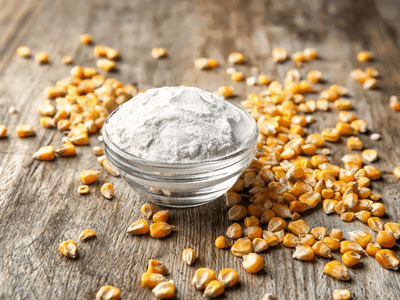Can I substitute Cornstarch for baking powder? One of my first mistakes in following a recipe was running out of baking powder. I had an abundance of cornstarch at the time and had no idea if it would work to replace baking powder. I never wanted to be in that stressful situation again, so I decided to look into baking powder substitutes.
In general, cornstarch cannot be used in place of baking powder. Cornstarch is used to thicken the batter, and baking powder is used to leaven it. Cornstarch thickens mixtures, whereas baking powder causes the dessert to rise.
When I decide to bake a cake for a family event, I make sure my pantry is fully stocked with all of the necessary ingredients. I’m not perfect, just like baking! I used this as a learning experience and discovered the most effective baking powder substitutes.
What Is the Difference Between Cornstarch and Baking Powder?
Despite their nearly identical appearances, cornstarch and baking powder are completely different!
Baking powder is more complex and contains multiple ingredients. Let us pretend to be mad scientists for a moment and talk about acids and bases. But don’t worry, I won’t harm your brain!
*By the way, you might be interested in my recent article on Is Baking Powder and Cornstarch the Same?
Can I Substitute Cornstarch for Baking Powder?

Can you use baking powder instead of cornstarch and vice versa? Baking powder and cornstarch are not the same thing. Baking powder is a leavening agent, which means it creates air bubbles in the batter, causing the cake to rise. Cornstarch is a thickening agent used to make puddings and pie fillings thicker.
Cornstarch is a handy ingredient to have on hand. I enjoy making pies with various fillings such as apple, blueberry, and lemon.
When my fillings become too loose for my liking, I add cornstarch to help thicken them up because its primary function is to thicken liquids.
Cornstarch is made from the starches of corn kernels, so any protein and fibers have been removed to create this refined, starchy powder.
What makes baking powder work is a combination of a base (typically sodium bicarbonate, also known as baking soda) and an acid (usually cream of tartar). When these two elements come together, a reaction occurs.
Take, for example, vinegar and baking soda. If you put baking soda in a bowl and pour vinegar over it, it will expand and fizz!
The reaction was caused by the combination of the acid (in this case vinegar) and the base (baking soda), and you can see bubbles forming and expanding visually. When we use baking powder in a recipe, we get the same reaction.
Baking powder is used in baking as a leavening agent to give desserts height.
Baking powder contains both an acid and a base in the form of dry ingredients. This enables us to store it in our pantries without it reacting on its own.
The timer starts ticking once we mix baking powder into our wet ingredients! Baking powder will gradually begin to activate, forming bubbles that will allow our cakes to rise and impress all of your guests!
Cornstarch Substitutes

1st: Arrowroot
The first cornstarch substitute option is arrowroot.
Arrowroot is a starchy flour made from the roots of plants in the Maranta genus found in the tropics.
The roots of the plants are dried and ground into a fine powder to make this flour, which can also be used as a thickener in cooking.
Some people prefer arrowroot to cornstarch because it contains more fiber. It forms a clear gel when mixed with water and is excellent for thickening clear fluids.
To achieve comparable results, experts recommend using arrowroot twice as much as cornstarch. It’s also gluten-free, so it’s suitable for those who avoid gluten.
Wheat Flour
Wheat flour is one of our top cornstarch substitutes, especially for thickening gravy, sauces, or stews.
It is a more nutritious alternative to cornstarch, with fewer carbohydrates, more protein, and more dietary fiber. It is also higher in minerals and vitamins.
Wheat flour is not as starchy as cornstarch, despite being more nutritious. This means that you should use more of it when cooking to achieve the same effect as cornstarch.
Wheat flour, like cornstarch, can form liquid lumps if not thoroughly mixed. So, before using it in recipes, try whisking the flour in warm water until it’s uniform. Also, make sure to fully cook flour before eating it.
Potato starch
Potato starch is the most popular cornstarch substitute.
Potato starch, as the name implies, is a powder made by extracting starch from potatoes and drying it out.
Potato starch contains a few nutrients, but it also has fewer calories and carbs than cornstarch, making it a good substitute for those looking to thicken foods without adding extra carbs and calories.
Because potato starch is relatively flavorless, it will not alter or overpower other flavors in foods. Because potatoes are naturally gluten-free, they are an excellent choice for those following a gluten-free diet or suffering from celiac disease.
It’s best to add potato starch later in the cooking process because starches can break down and lose their thickening properties if they overheat.
To sum up…

Baking does not have to be a stressful activity! I am a forgetful person who sometimes fails to notice that I have used up an ingredient and have yet to purchase it.
I’ve learned over the years that baking doesn’t have to be stressful because there are so many ways to substitute ingredients in your recipes!
Baking powder is one of those ingredients that has numerous substitutes, and after spending time perfecting ratios and understanding the science behind it, you will never run out of baking powder again.